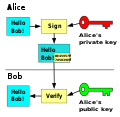The Blum–Micali algorithm is a cryptographically secure pseudorandom number generator. The algorithm gets its security from the difficulty of computing...
3 KB (402 words) - 03:33, 28 April 2024
University of California, Berkeley in 1982; for research supervised by Manuel Blum. Micali has been on the faculty of MIT's Electrical Engineering and Computer...
9 KB (637 words) - 18:41, 27 April 2025
retrieved 2010-01-24. Manuel Blum at DBLP Bibliography Server Manuel Blum publications indexed by Microsoft Academic Blum, Manuel; Micali, Silvio (1984). "How...
10 KB (722 words) - 13:43, 5 June 2025
The Goldwasser–Micali (GM) cryptosystem is an asymmetric key encryption algorithm developed by Shafi Goldwasser and Silvio Micali in 1982. GM has the distinction...
7 KB (976 words) - 18:47, 24 August 2023
Cryptographically secure pseudorandom number generator (category Cryptographic algorithms)
the Blum Blum Shub algorithm. However the algorithm is very inefficient and therefore impractical unless extreme security is needed. The Blum–Micali algorithm...
29 KB (3,633 words) - 08:24, 16 April 2025
The Commercial National Security Algorithm Suite (CNSA) is a set of cryptographic algorithms promulgated by the National Security Agency as a replacement...
10 KB (655 words) - 20:05, 23 June 2025
slow to be practical in most applications. They include: Blum–Micali algorithm (1984) Blum Blum Shub (1986) Naor–Reingold pseudorandom function (1997) These...
23 KB (1,461 words) - 21:24, 2 July 2025
RSA cryptosystem (redirect from RSA algorithm)
Ron Rivest, Adi Shamir and Leonard Adleman, who publicly described the algorithm in 1977. An equivalent system was developed secretly in 1973 at Government...
60 KB (7,783 words) - 01:35, 9 July 2025
cryptography, the Double Ratchet Algorithm (previously referred to as the Axolotl Ratchet) is a key management algorithm that was developed by Trevor Perrin...
15 KB (1,391 words) - 09:37, 22 April 2025
cryptography, the Elliptic Curve Digital Signature Algorithm (ECDSA) offers a variant of the Digital Signature Algorithm (DSA) which uses elliptic-curve cryptography...
19 KB (2,833 words) - 08:53, 8 May 2025
also point out that the blossom algorithm and the algorithms by Micali and Vazirani can be seen as approximation algorithms running in linear time for any...
10 KB (1,317 words) - 15:41, 14 June 2025
The Digital Signature Algorithm (DSA) is a public-key cryptosystem and Federal Information Processing Standard for digital signatures, based on the mathematical...
16 KB (2,221 words) - 09:42, 28 May 2025
the more complicated algorithm of Micali and Vazirani. The Hopcroft–Karp algorithm can be seen as a special case of Dinic's algorithm for the maximum-flow...
25 KB (3,746 words) - 14:52, 14 May 2025
The Blum–Goldwasser (BG) cryptosystem is an asymmetric key encryption algorithm proposed by Manuel Blum and Shafi Goldwasser in 1984. Blum–Goldwasser is...
9 KB (2,131 words) - 04:08, 5 July 2023
Ron Rivest (section Algorithms)
GMR public signature scheme, published with Shafi Goldwasser and Silvio Micali in 1988,[C3] and of ring signatures, an anonymized form of group signatures...
27 KB (1,543 words) - 18:26, 27 April 2025
ElGamal encryption (redirect from ElGamal encryption algorithm)
cryptography, the ElGamal encryption system is an asymmetric key encryption algorithm for public-key cryptography which is based on the Diffie–Hellman key exchange...
10 KB (1,473 words) - 11:12, 31 March 2025
The Cayley–Purser algorithm was a public-key cryptography algorithm published in early 1999 by 16-year-old Irishwoman Sarah Flannery, based on an unpublished...
7 KB (1,139 words) - 08:53, 19 October 2022
Goldreich verifying that a two-prime modulus is not a Blum integer. Oded Goldreich, Silvio Micali, and Avi Wigderson took this one step further, showing...
64 KB (7,955 words) - 09:34, 4 July 2025
Rabin cryptosystem (section Algorithm)
remainder theorem). Topics in cryptography Blum Blum Shub Shanks–Tonelli algorithm Schmidt–Samoa cryptosystem Blum–Goldwasser cryptosystem Galbraith, Steven...
14 KB (2,077 words) - 14:01, 26 March 2025
"Hash trees"), and Rabin signatures. In 1988, Shafi Goldwasser, Silvio Micali, and Ronald Rivest became the first to rigorously define the security requirements...
40 KB (4,934 words) - 16:11, 14 July 2025
Paillier cryptosystem (section Algorithm)
and named after Pascal Paillier in 1999, is a probabilistic asymmetric algorithm for public key cryptography. The problem of computing n-th residue classes...
13 KB (1,929 words) - 21:01, 7 December 2023
Mental poker (category Cryptographic algorithms)
led to the definition of semantic security by Shafi Goldwasser and Silvio Micali. The concept of multi-player mental poker was introduced in Moti Yung's...
15 KB (2,399 words) - 22:20, 4 April 2023
Schnorr signature (redirect from Schnorr signature algorithm)
Schnorr signature is a digital signature produced by the Schnorr signature algorithm that was invented by Claus Schnorr. It is a digital signature scheme known...
9 KB (1,248 words) - 02:36, 3 July 2025
encryption scheme. They are also used in several integer factorization algorithms that have applications in cryptography, such as Lenstra elliptic-curve...
39 KB (4,677 words) - 07:29, 27 June 2025
assumptions: examples include the Micali–Schnorr generator, Naor-Reingold pseudorandom function and the Blum Blum Shub algorithm, which provide a strong security...
28 KB (3,559 words) - 14:58, 27 June 2025
Gilbert Vernam • GMR (cryptography) • GNU Privacy Guard • GnuTLS • Goldwasser–Micali cryptosystem • Gordon Welchman • GOST (block cipher) • GOST (hash function)...
67 KB (2,932 words) - 17:47, 12 July 2025
its "Private Conversations". The protocol combines the Double Ratchet Algorithm, prekeys (i.e., one-time ephemeral public keys that have been uploaded...
35 KB (3,055 words) - 19:21, 10 July 2025
Kyber (category Asymmetric-key algorithms)
the second phase of the selection process, several parameters of the algorithm were adjusted and the compression of the public keys was dropped. Most...
15 KB (1,472 words) - 07:57, 9 July 2025
Merkle–Hellman knapsack cryptosystem (category Broken cryptography algorithms)
problem is "easy" and solvable in polynomial time with a simple greedy algorithm. In Merkle–Hellman, decrypting a message requires solving an apparently...
10 KB (1,852 words) - 02:34, 9 June 2025
with Silvio Micali, an algorithm for finding maximum matchings in general graphs; the latter is still the most efficient known algorithm for the problem...
10 KB (860 words) - 17:23, 18 June 2025








